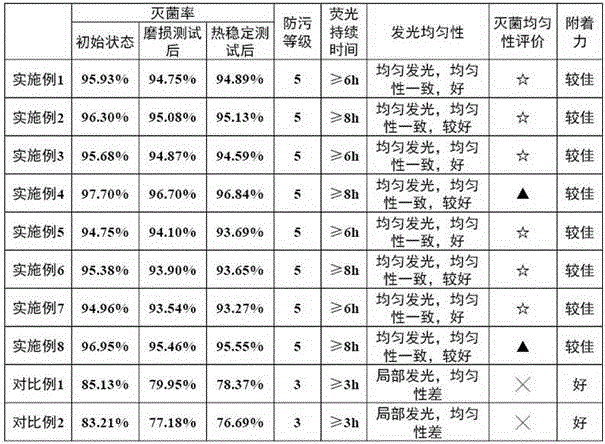Noctilucent antibacterial lead and cadmium-free low-temperature frit and preparing method thereof
A low-temperature frit and melting technology, used in the field of ceramics, can solve the problems of poor luminescence and antibacterial effects, unsuitable for direct addition of antibacterial agents, long afterglow luminescent materials, and highly toxic
- Summary
- Abstract
- Description
- Claims
- Application Information
AI Technical Summary
Problems solved by technology
Method used
Image
Examples
Embodiment 1
[0036] A luminous antibacterial lead-free cadmium low-temperature frit and a preparation method thereof, the preparation method comprising the following steps:
[0037] A mixture: mix and grind 12% quartz, 12% feldspar, 15% borax, 8% carbonate, 35% boric acid, 8% spodumene, 4% fluoride salt, 0.9% kaolin, and then add 0.1 % antibacterial compound and 5% luminous powder compound, grind uniformly to make mixture; described feldspar is obtained by mixing potassium feldspar and albite feldspar in a weight ratio of 4:1; described carbonate is made of potassium carbonate, carbonic acid Sodium, barium carbonate, lithium carbonate and calcium carbonate are mixed in a weight ratio of 3:1:3:2:1; the fluoride salt is obtained by mixing sodium fluoride, calcium fluoride and lithium fluoride in a weight ratio of 4:2: 1 mixed;
[0038] B Melting: Sprinkle the mixture prepared in step A into a refractory sagger, and perform high-temperature melting at 1250~1320°C to obtain a molten slurry; t...
Embodiment 2
[0050] A luminous antibacterial lead-free cadmium low-temperature frit and a preparation method thereof, the preparation method comprising the following steps:
[0051] A mixture: mix and grind 15% quartz, 6% feldspar, 23% borax, 10% carbonate, 28% boric acid, 6% spodumene, 3% fluoride salt, and 3% kaolin, and then add 3 % antibacterial compound and 3% luminous powder compound, grind uniformly and make mixture; Described feldspar is obtained by mixing potassium feldspar and albite feldspar by weight ratio 4:1; Described carbonate is made of potassium carbonate, carbonic acid Sodium, barium carbonate, lithium carbonate and calcium carbonate are mixed in a weight ratio of 3:1:3:2:1; the fluoride salt is obtained by mixing sodium fluoride, calcium fluoride and lithium fluoride in a weight ratio of 4:2: 1 mixed;
[0052] B Melting: Sprinkle the mixture prepared in step A into a refractory sagger, and perform high-temperature melting at 1250~1320°C to obtain a molten slurry; the h...
Embodiment 3
[0064] A luminous antibacterial lead-free cadmium low-temperature frit and a preparation method thereof, the preparation method comprising the following steps:
[0065] A mixture: mix and grind 18% quartz, 5% feldspar, 25% borax, 12% carbonate, 24% boric acid, 4% spodumene, 1% fluoride salt, 5% kaolin, and then add 5 % antibacterial compound and 1% luminous powder compound, grind uniformly to make mixture; described feldspar is obtained by mixing potassium feldspar and albite feldspar by weight ratio 4:1; described carbonate is made of potassium carbonate, carbonic acid Sodium, barium carbonate, lithium carbonate and calcium carbonate are mixed in a weight ratio of 3:1:3:2:1; the fluoride salt is obtained by mixing sodium fluoride, calcium fluoride and lithium fluoride in a weight ratio of 4:2: 1 mixed;
[0066] B Melting: Sprinkle the mixture prepared in step A into a refractory sagger, and perform high-temperature melting at 1250~1320°C to obtain a molten slurry; the high-t...
PUM
| Property | Measurement | Unit |
|---|---|---|
| The average particle size | aaaaa | aaaaa |
Abstract
Description
Claims
Application Information
 Login to View More
Login to View More - R&D
- Intellectual Property
- Life Sciences
- Materials
- Tech Scout
- Unparalleled Data Quality
- Higher Quality Content
- 60% Fewer Hallucinations
Browse by: Latest US Patents, China's latest patents, Technical Efficacy Thesaurus, Application Domain, Technology Topic, Popular Technical Reports.
© 2025 PatSnap. All rights reserved.Legal|Privacy policy|Modern Slavery Act Transparency Statement|Sitemap|About US| Contact US: help@patsnap.com

